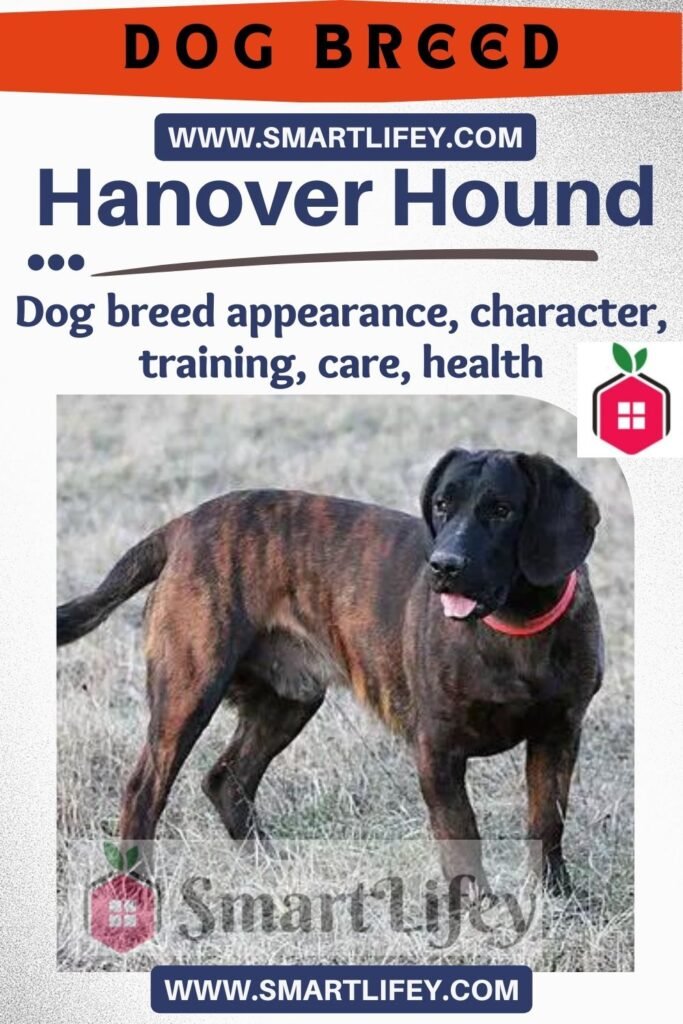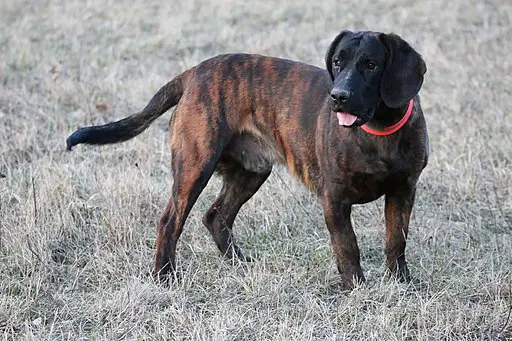
Among the characteristics of the Hannover Hound, its strong , resistant and well-proportioned appearance stands out. It has a calm, loving and self-confident character. It is one of the most appreciated hunting dogs in Germany. At Petlifey, we explain everything about the Hanoverian hound dog breed.
Hannover Hound breed characteristics
The Hanover Hound is a blood dog with very peculiar characteristics. Thanks to its determination and persistence, as well as its very fine sense of smell, it is able to follow the trail of a downed piece for days.
Its work style is harmonious, sometimes even slow, as it is not in a hurry to find a prey that intends to flee. Even so, despite being specialized in these tasks, it can also perform other more traditional types of hunting with great success.
Although the breed in general is little known, because even in its native country its cousin the Bavarian blood hound enjoys much more popularity, this is a balanced hound, with good temperament, active and very funny, qualities that make them a good companion dog, despite the fact that its presence in the family environment is still very limited.
Let’s see in more detail what the Hannover Hound looks like and its physical characteristics :
Hannover Hound Character
The Hannover Hound is a dog with a calm and confident character. It shows a sensitive temperament towards its owner and selective and reserved towards strangers. When it tracks it maintains a very high concentration
Regarding its behaviour, it is an affectionate and very stable animal, which dedicates all its affections to its family and gets along well with children.
With strangers, on the other hand, it is reserved and distant, and specimens that have not been subjected to a good socialization work at an early stage may even show traits of some aggressiveness.
The Hannover Hound is, above all, a working dog whose personality makes it like to go out into the countryside to hunt or take long walks in the wild to satisfy its high exercise needs , although it can spend time quietly sitting or sleeping at feet of its master.
It needs a lot of space , so it is not the most recommended choice for people who live in the city.
Therefore, it is not an apartment dog , but it can be a good choice for active people and athletes who, without needing to like hunting, are lovers of outdoor activities , such as running or riding in bicycle accompanied by your dog, or other organized such as agility or flyball .
- Energy: a Very active and with a very high level of energy, you need to do a lot of intense exercise every day.
- Temperament: it is a vigorous dog, tireless worker, persistent and somewhat independent, but solicitous with its master, with whom it is affectionate.
- Adaptability: medium / Low. It needs a lot of space and to be able to run freely, so it does not suit life in a city apartment at all.
- Sociability: It is very affectionate with people around them, but suspicious, distant and even aggressive with strangers.
- Health: There are hardly any serious diseases associated with the breed.
- Longevity: medium / High. Live between 10 and 15 years.
- Utility: versatile. Basically it is a hunting dog, although it is also a good tracker it can be used for company.
- Use: hunting and company.
Physical characteristics of the Hanover Hound
The Hannover Hound is a well proportioned and strong looking and general appearance dog , it is endowed with good musculature that enables it for hard and thankless work.
The chest, wide and deep, with excellent thoracic capacity, allows long hours of demanding work.
What is the Hanover Hound physically like?
Its body is muscular and compact, this hound has a body structure more elongated than tall, a robust body, a powerful back and a slightly curved dorsal line up to the croup, which is high and well developed.
The head is broad. One of the characteristics of this breed of dog is the slight wrinkles on the forehead. The muzzle is strong and deep, and the nose is broad, large and black or dark brown.
Their eyes are more or less dark brown and tight-fitting lids are neither bulging nor sunken. Denotes a serious and calm expression.
It has medium-sized, smooth and flat ears , and they have a rounded edge. They hang close to the cheeks. They are inserted high, above the line of the eyes.
The feet are round and strong. Its toes are arched and close together. It has large, hard footpads and strong, dark-colored nails.
The tail is set high and thick at the start; the tip is slightly finer and has a slight fringe of hair at the end. It reaches the hocks.
As for its coat, the hair is short, dense and rough. It has a deer red color that can be lighter or darker, as well as more or less brindle. It can also have a mask. Let’s now see what the breed standard of the Hanover Hound looks like :
Hannover Hound breed standard
- General appearance: strong, resistant, well proportioned and with a broad and deep chest, it has a very serious expression.
- Size: medium / large.
- Height at the withers: between 50 and 55 cm for males and between 48 and 53 cm for females.
- Weight: between 30 and 40 kg for males and between 25 and 35 kg for females.
- Other names: Hanoverian Scenthound / Chien de recherche au sang du Hanovre / Hannoverscher Schweisshund.
- Body: muscular and well structured, it is endowed with good bones.
- Head: presents a forehead with wrinkles characteristic of this breed.
- Skull: it is broad, especially in the posterior area, and slightly domed. The occipital protuberance appears poorly developed and the superciliary arch, clearly marked.
- Muzzle: strong, deep and wide, occupying the middle of the head; it is well developed for its tracker job.
- Nose: broad, large, with well-open nostrils and generally black or dark brown.
- Eyes: neither bulging nor sunken; their eyelids are close to the eyeball and their irises are dark brown.
- Ears: they are of medium length, smooth and flat, set high. They hang close to the head and have a rounded edge.
- Nose-frontal depression (stop): it is very marked, especially in males.
- Jaws: very strong, normally developed, they house a set of 42 teeth. The bite is regular and complete in scissors, although there are specimens that close in pincers.
- Neck: it is long and strong and gradually widens towards the chest; the skin of the throat sometimes forms a slight dewlap.
- Chest: houses a good rib cage and is deeper than wide.
- Back: strong, with a slightly arched loin, broad and flexible. The rump is wide and long, sloping gently towards the tail.
- Forelimbs: straight, parallel and well proportioned with the rest of the body. Shoulders: They are flat, muscular and oblique. Forearms and arms: The former are straight and muscular. The seconds are long. Elbows: Set back well angled.
- Hind limbs: seen in profile, they are not always vertical to the body; good angulation. Seen from behind they are straight, with a wide and spacious pelvis. The legs are straight and thin; the thighs are well muscled. Its knees are well angled. The hocks are correctly angled.
- Feet: strong and round, with well arched and close toes, large rough pads, and strong nails.
- Tail: set high, long and slightly arched, narrower as it approaches the tip. The dog wears it drooping between the hind limbs and slightly arched.
- Skin: thick and loose, it forms characteristic folds especially on the head and sometimes in the throat area.
- Color: it is deer red, more or less brindle, sometimes with a mask.
- Hair : the coat is short, hard, rough, dense and tight, somewhat longer and thicker on the back of the thigh and on the lower part of the tail.
- Movement: it moves with all types of movement, with a strong and elastic thrust, which covers the surface well during the gallop. Its preferred movement during work is to walk or gallop.
- FCI Classification: FCI No. 213. Group No. 6 – Bloodhounds, Trace Dogs and Similar Breeds. Section 2 – Trace Dogs.
Education and training of the Hannover Hound
As for how to train the Hannover Hound, it is an intelligent and easy to train dog, but it needs an owner with a minimum of experience who can guarantee a consistent and coherent work, even if it has to resort to the advice of professionals in The matter.
At present, its ability to locate and track blood traces, some already cold or even several days old, is highly appreciated by forest and hunting rangers.
An indefatigable worker, when it begins a search it acts with a certain degree of independence, although it does not stop being solicitous with the requirements of its master or guide.
For all these reasons, at present the breed continues to maintain its prestige among German hunters, especially in the area of influence of the city of Hannover , although despite its great qualities it remains a great unknown in most countries.
Health and diseases of the Hanover Hound breed

Being a working dog, it is generally a healthy, strong animal and little prone to serious diseases.
To ensure its good health, it is enough to provide them with a balanced diet, an adequate exercise program and a basic veterinary check-up.Above all, with special attention to the state of your ears and the review of the most sensitive areas after a day of hunting to prevent any possible wounds that have been made from becoming infected.
